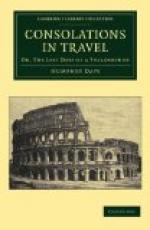more evidence of its utility, I employ it without
putting the least confidence in its power; nor do I
expose myself to the same danger as my friend has
done for the sake of an experiment.” I
said, “I believe several scientific persons—Brocchi
amongst others—have doubted the existence
of any specific matter in the atmosphere producing
intermittent fevers in marshy countries and hot climates;
and have been more disposed to attribute the disease
to physical causes, dependent upon the great differences
of temperature between day and night and to the refrigerating
effects of the dense fogs common in such situations
in the evening and morning; and, on this hypothesis,
they have recommended warm woollen clothing and fires
at night as the best preventives against these destructive
diseases, so fatal to the peasants who remain in the
summer and autumn in the neighbourhood of the maremme
of Rome, Tuscany, or Naples.” The stranger
said, “I am acquainted with the opinions of the
gentlemen, and they undoubtedly have weight; but that
a specific matter of contagion has not been detected
by chemical means in the atmosphere of marshes does
not prove its non-existence. We know so little
of those agents that affect the human constitution,
that it is of no use to reason on this subject.
There can be no doubt that the line of malaria above
the Pontine marshes is marked by a dense fog morning
and evening, and most of the old Roman towns were
placed upon eminences out of the reach of this fog.
I have myself experienced a peculiar effect upon
the organs of smell in the neighbourhood of marshes
in the evening after a very hot day; and the instances
in which people have been seized with intermittents
by a single exposure in a place infested by malaria
in the season of fevers gives, I think, a strong support
to something like a poisonous material existing in
the atmosphere in such spots; but I merely offer doubts.
I hope the progress of physiology and of chemistry
will at no very distant time solve this important
problem.” Ambrosio now came forward, and
bowing to the stranger, said he took the liberty,
as he saw from his familiarity with the cicerone that
he was well acquainted with Paestum, of asking him
whether the masses of travertine, of which the Cyclopean
walls and the temples were formed, were really produced
by aqueous deposition from the River Silaro, as he
had often heard reported. The stranger replied,
“that they were certainly produced by deposition
from water; and such deposits are made by the Silaro.
But I rather believe,” he said, “that
a lake in the immediate neighbourhood of the city
furnished the quarry from which these stones were
excavated; and, in half an hour, if you like, after
you have finished your examinations of the temples
with your guide, I will accompany you to the spot
from which it is evident that large masses of the
travertine, marmor tiburtinum, or calcareous tufa,
have been raised.” We thanked him for
his attention, accepted his invitation, took the usual




